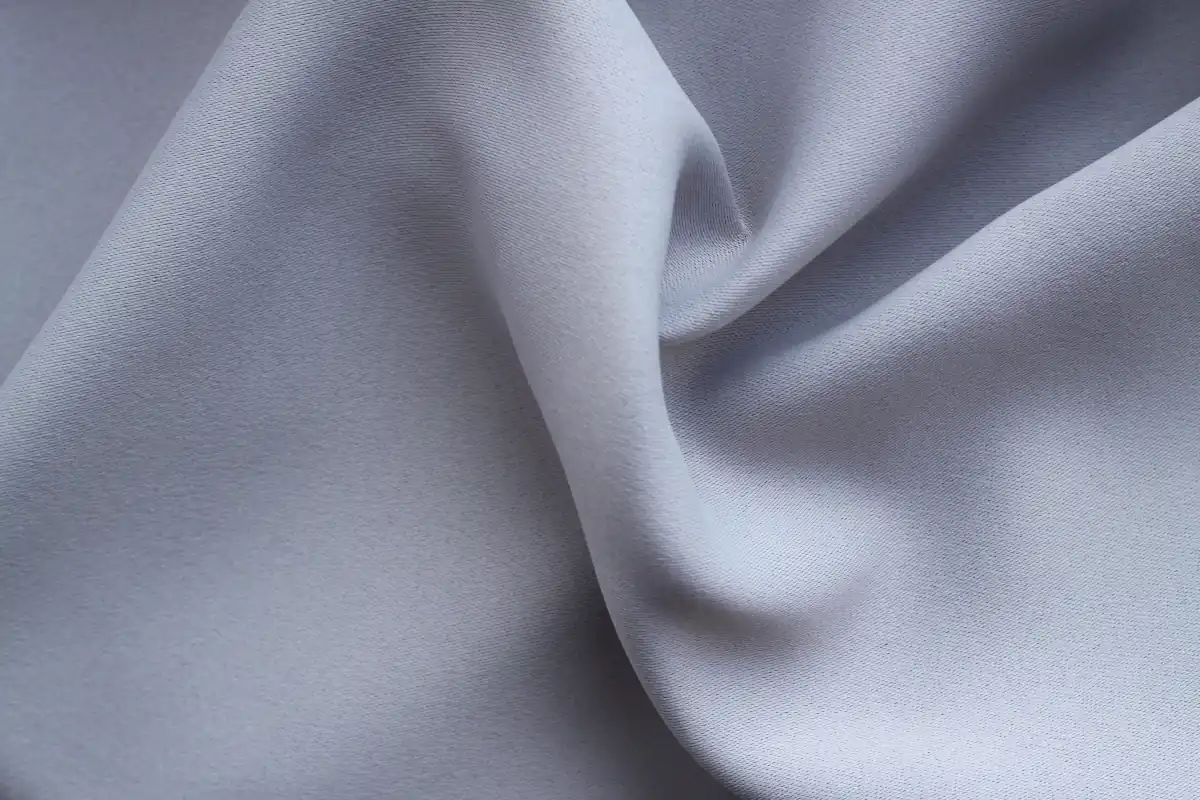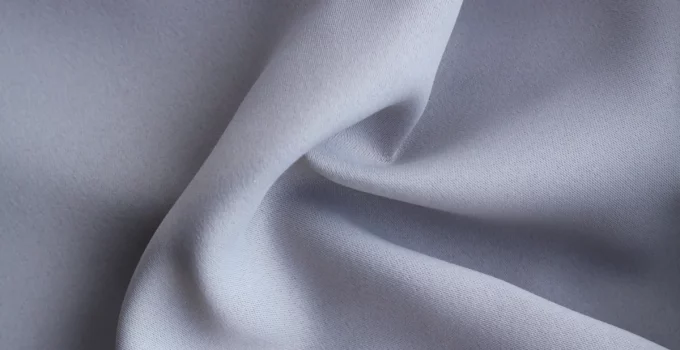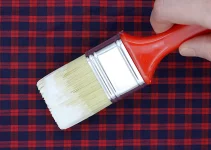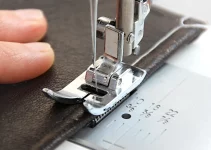Answering a question like is nylon stretchy is easy because nylon is stretchy. We could leave it at that but I can never give such a simple and direct answer when it comes to popular fabrics that are such an integral part of our lives.
If we pull nylon in every direction with force at the same time, it will stretch. But it also has elastic recovery so it will return to its normal size immediately after letting it go, as long as it’s not stretched beyond its elastic range.
Thus, it doesn’t lose its shape and it holds up well to intensive use, which is awesome to know.
I should also let you know that nylon is not the most stretchy fabric we can work with. The most stretchy is spandex/lycra/elastane. Other examples of fabrics that stretch are knits and neoprene. Even fleece can be regarded as having some stretch.
However, polyester is one synthetic that doesn’t stretch. We could call it a big exception among synthetic fibers.
When I wrote an article answering the question is viscose rayon stretchy, I mentioned that it’s not because there is no elasticity in its fibers. But rayon is also a semi-synthetic fabric.
Thus, I thought I should talk about a popular synthetic fabric to see if it’s stretchy or not.
And that’s how I ended up wanting to answer the question is nylon stretchy. And it turns out that the answer is definitely yes, nylon stretches.
If you’re interested in learning more about another popular synthetic fabric, you should also check out my article about fleece and whether it shrinks or not.
Is Nylon Stretchy? How About Nylon Blends?

The most direct answer that we could offer to the question is nylon stretchy is yes. This is the simple answer.
However, answering the question does nylon stretch can also receive a more complex answer, although the basics still remains that nylon is stretchy.
Nevertheless, the complex answer is this: how much stretch nylon has depends on its make and blend.
Thus, we’re going to be delving into how much pure rayon can be stretched.
And we’re also going to be talking about nylon blends, like: nylon spandex, polyester nylon blend, nylon cotton (NyCo), and nylon knits. These blends are created by weaving or knitting together different fibers to obtain even more interesting materials.
Nylon and blends can also be dyed. You can learn more in my recommendations for the best black dye for clothes.
You can also check out my article answering the question is acrylic itchy.
1. Pure rayon
If we talk about pure rayon, meaning it’s not blended with other fibers, then we can say that we get a 15 to 30% stretch from its original size.
Beyond that, the fibers can break.
It’s still a pretty good amount of stretch but that’s pretty much what we can expect when it comes to synthetic fabrics. Polyester is a notable exception because it doesn’t have any elasticity.
Natural fabrics, like wool, silk, linen and cotton, are not exactly famous for their stretchy qualities. If any of these natural fabrics stretch, that happens over time, after hundreds of wears or uses, like it might be the case with cotton.
2. Nylon spandex
Whenever we want to get more stretch, the answer that should come up is this: combine spandex with the fibers we want to have more stretch.
After all, spandex/lycra is the stretchiest in the industry.
To understand just how stretchy spandex is, you should know that it can stretch to 5-8 times its normal size. That’s just impressive.
90%10 nylon and 10% spandex will feel thick and soft to touch.
82% nylon and 18% spandex is stretchy and lightweight.
For even more stretch, you can choose a 80% nylon 20% spandex blend.
You can read more about different blends between these two stretchy fibers here.
3. Nylon knit jersey
This is another blend that has a good stretch. Actually, whenever you see knits that’s what you should assume.
This blend can be great for leotards, swimwear, activewear, and shapewear lingerie.
It has a four way stretch, 20% across the grains and 15% vertical. It’s also a material that feels smooth and silky.
4. Polyester nylon
You might know about polyester as one of the best threads to be used in sewing machines. All purpose polyester has the reputation of being one of the strongest sewing threads, if we ignore kevlar thread. And it has good stretch without breaking, running smoothly at high speeds without looping.
You might know about it as the thing fleece is made from. Although, we also can buy cotton fleece.
And you might also know about polyester simply because it’s one of the most popular textiles in the world. Our world wouldn’t be the same without this synthetic fabric.
However, another thing to know about polyester is that its fibers have no elasticity.
Thus, a polyester nylon blend won’t have more stretch than pure rayon because polyester fibers don’t stretch.
In this blend, nylon is the more stretchy of the two.
The polyester nylon fabric is used for making sleek windbreakers, rain jackets and coats due to the material’s lightweight and water resistance qualities.
5. Nylon cotton (NyCo)
Since cotton is a natural material that doesn’t stretch much at all, that means that weaving or knitting together fabrics of cotton and nylon, won’t make the material more stretchy than pure nylon is.
We could say that cotton stretches by 3-5% but that’s not much.
Does Nylon Shrink?
We already established that the answer to the question is nylon stretchy is yes.
Now, we should see if it shrinks.
The good news is that rayon doesn’t shrink easily.
If you have something made of pure nylon and you want it to shrink, you don’t stand too much chance of achieving it.
Your only option is to hem the garment down to the right size. Your best recourse is your sewing machine rather than the dryer on medium heat.
However, as we saw, there is also the question of fabric blends.
Certain nylon blends can shrink
If nylon is mixed with wool, cotton or linen in an almost 50%-50% blend, then you have a chance to shrink your garment in the washing machine or dryer.
However, you should also keep in mind that it might contract only temporarily.
Plus, shrinking, even when it’s successful, will change both the width and the length. If you only want to shorten your garments, hemming is always the right way to go for the most satisfactory results.
If you want to shrink a nylon blend in the washing machine, you should wash the garment on the hottest available water setting and the longest wash cycle.
You can also add ½ cup of ammonia to preserve the colors.
Afterwards, dry it on medium heat in the dryer for about 15 minutes. If you turn the dryer on hot, that might melt the nylon fabrics. It’s a thing you should remember for all synthetic fabrics made from petroleum products.
I don’t approve of the washing machine-dryer shrinking combo because the garment might not shrink evenly, we might have to repeat the process a few more times, and you’ll never know for sure what you’ll end up with in the end.
Hemming, if possible, sounds just so much more practical and you can actually see the exact changes you want to make.
What Is Nylon?
We’ve answered the question does nylon stretch in the affirmative and we’ve also talked about popular blends and how they differ from the pure fibers. We also saw that it’s a material that generally doesn’t shrink.
Now, we should actually understand what exactly nylon is. We’ll also briefly touch on how it’s made. And what uses it has, especially in the clothing industry since this is a website about sewing and for talking about the best sewing machines for our needs.
Simply put, nylon is plastic. Just like polyester and acrylic.
More technically, nylons are a family of materials called polyamides. They’re made from reacting carbon-based chemicals found in coal and petroleum. The chemical reaction takes place in a high-pressure, heated environment.
The chemical reaction known as condensation polymerization results in a large polymer in the form of a sheet of nylon.
The sheet is then broken into chips, melted and drawn through a spinneret, which produces the individual fibers that are woven into fabric.
Moreover, nylon is considered the first fabric that was made entirely in a laboratory. We could say that this invention was the dawn of the age of synthetic, although most of us would associate that beginning with polyester.
World War II was the time when nylon became widely available to the general public.
Thanks to its strength and durability, nylon was used for military products during World War II: tents, ropes, tires, parachutes.
Subsequently, it also replaced everything that was made of silk, like silk stockings. It seems fitting since nylon was developed as a cheap and plentiful alternative to silk.
Nylon stockings were first sold in 1939. It’s a clear example of a product that demonstrates that nylon fibers have elasticity. Stockings also came to be addressed by the name nylon.
Fabric weight
Nylon is a medium weight fabric.
That means that if you want to use your sewing machine on some nylon materials, you can use a pretty average sewing machine, even models that cost around $100-$150.
You don’t necessarily need a heavy-duty sewing machine, like the ones from Singer and Brother, but they certainly can be wonderful on all types of materials.
When sewing nylon, I recommend using a 70/10 ball-point needle.
Properties
Nylon is a synthetic wonder, there’s no other way to describe it.
Among its most notable properties, we have: elastic, thus our answer to the question does nylon stretch, lustrous, very strong, resilient, damage resistant to oil and many chemicals, dries quickly and does not absorb water.
Nylon uses
To understand just how full our everyday life is of this synthetic fabric, we can consider that our umbrellas are made from it, some of our carpets in the house contain nylon fibers, our bowls can be made from it and even the bristles on our toothbrush.
It’s why I always say that our world would not be the same without synthetic fibers. They’re pretty much surrounding us from all directions.
We saw just how many important properties it has so it’s no wonder that its uses are so widespread.
It’s used in:
- clothing (underwear, lingerie, swimwear, activewear, cycle wear, raincoats, shirts, etc.)
- umbrellas, backpacks, bags, flak jackets
- industrial uses (parachutes, tents, thread, tarpaulins, nets and ropes, airbags, conveyer and seat belts, plastic fasteners)
- fishnet making
- cookware because it has a relatively high continuous service temperature (spatulas, spoons, bowls, forks, tongs, brushes, etc.)
Eco-friendly nylon
We all know that petroleum-derived synthetic fibers are not exactly good for the planet. However, they’re also some of the most used materials across many industries so it’s not like that is going to change soon.
However, for those who are looking for eco-friendly options, there are some to choose from.
In my article on fleece, I mentioned that there are also fleece materials made from recycled plastic bottles.
Thus, synthetic fibers made from harvested waste is the eco-friendly option we can choose.
There have been good developments in harvesting waste and repurposing it into fibers, even luxurious fibers.
The main sources are PET bottles, recycled fishing nets, plastic waste collected by networks, ocean plastic, etc.
If you want to know more about how this works, I recommend checking out econyl.com. Econyl, standing for regenerated nylon, is a manufacturer of eco-friendly nylon that has even collaborated with Prada to replace their iconic nylon accessories line with recovered ocean plastic material.
Read my post on can you spray paint fabric if you are interested in having some fun DIY projects.
All in all, I hope you enjoyed this foray into nylon that started by answering a simple question: is nylon stretchy?




